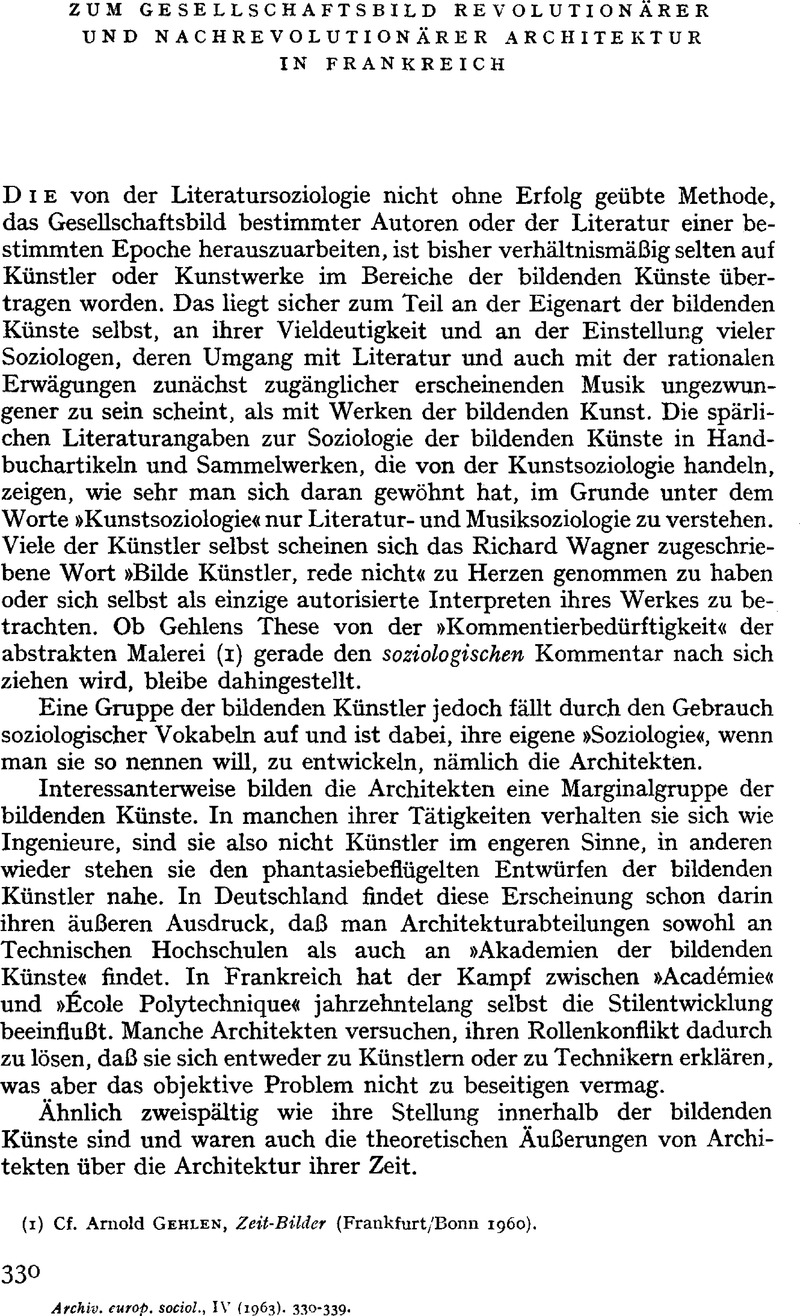No CrossRef data available.
Article contents
Zum Gesellschaftsbild revolutionärer und nachrevolutionärer Architektur in Frankreich
Published online by Cambridge University Press: 28 July 2009
Abstract

- Type
- Notes Critiques
- Information
- European Journal of Sociology / Archives Européennes de Sociologie , Volume 4 , Issue 2 , December 1963 , pp. 330 - 339
- Copyright
- Copyright © Archives Européenes de Sociology 1963
References
(1) Cf. Gehlen, Arnold, Zeit-Bilder (Frankfurt/Bonn 1960).Google Scholar
(2) Cf. Hauser, Arnold, Sozialgeschichte der Kunst und Literatur (München 1953), Bd. I, S. 137.Google Scholar
(3) Zitiert bei De Lauwe, Chombart, Famille et habitation (Paris 1959), S. 135.Google Scholar
(4) Kaufmann, Emil, Von Ledoux bis Corbusier (Wien 1933), S. 14.Google Scholar
(5) Ledoux, Claude-Nicolas, L'architecture considérée sous le rapport de l'art, des mœurs et de la législation (Paris 1804), S. 70.Google Scholar
(6) Cf. Cassirer, Ernst, Die Philosophie der Aufklärung (Tübingen 1932), S. 57 f.Google Scholar
(7) Rosenau, Helen schreibt in ihrer Einführung zu Boullée's Treatise on Architecture (London 1953), S. 12Google Scholar, über den Natur begriff Boullees: »Es würde irrig sein, Boullée als Romantiker anzusehen, da sein Individualismus auf einer reflektierten Auffassung der Funktion beruhte und durch die Anerkennung der durch die Theorien von Newton begründeten Naturgesetze beherrscht wurde.«
(8) Cf. Zeitler, R., Klassizismus und. Utopia (Stockholm 1947), S. 204.Google Scholar
(9) Ledoux, , op. cit. S. 114.Google Scholar
(10) Rosenau, Helen, The Ideal City in its Architectural Evolution (London 1959), S. 92.Google Scholar
(11) Diderot, , Encyclopédie ou Dictionnaire raisonné des sciences, des arts et des métiers, 1778Google Scholar.
Cf. auch Dresdner, Albert, Die Entstehung der Kunstkritik (München 1915).Google Scholar
(12) De Quincy, Quatremère, »Architecture«, Encyclopedie méthodique (Paris 1785–1820), I, S. 508.Google Scholar
(13) Kaufmann, , Von Ledoux zu Le Corbusier, S. 16 sq.Google Scholar
(14) Ledoux, , op. cit. S. 72.Google Scholar
(15) Bloch, Ernst, Prinzip Hoffnung (Berlin 1955), Bd. II, S. 317.Google Scholar
(16) De Lauwe, Chombart, op. cit. S. 139.Google Scholar Cf. auch Balladur, M., »Le dedans et le dehors«, in Les Temps modernes, 11 1949, Nr. 49.Google Scholar
(17) Rosenau, Helen, The Ideal City, S. 72.Google Scholar
(18) Helen Rosenau, ibid. S. 78.
(19) Kaufmann, , Von Ledoux zu Le Corbusier, S. 31 sq.Google Scholar
(20) Daß der preußische Klassizismus Ledoux viel zu verdanken hat, dürfte offensichtlich sein (cf. Kaufmann, , in Kritische Berichte 1931/1932, S. 208, 212).Google Scholar
(21) Cf. Hautecœur, , Histoire de l'architecture en France (Paris 1953), Bd. V, S. 258–263.Google Scholar
(22) Über das Verhältnis Durands zu Boullée: Kaufmann, E., »Three Revolutionary Architects, Boullée, Ledoux and Lequeu«, in Transactions of the American Philosophical Society, Bd. XLII, Teil III (Philadelphia 1952)Google Scholar, and Hautecœur, Louis, op. cit. S. 70–80.Google Scholar
(23) Kaufmann, , Architecture in the Age of Reason. Baroque and Post-Baroque in England, Italy and France (Cambridge 1955), S. 213.CrossRefGoogle Scholar
(24) Sedlmayr, Hans, Verlust der Mitte (Berlin 1959), S. 65 sq.Google Scholar
(25) Sedlmayr, Hans, op. cit. S. 64.Google Scholar
(26) Cf. hierzu die Kritik von Rosenau, Helen an Sedlmayr, und Kaufmann, , in Ideal City, S. 80.Google Scholar
(27) Cf. Benoit, , L'art français sous la Révolution et l'Empire (Paris 1897).Google Scholar
(28) Kaufmann, Zitiert nach, Architecture in the Age of Reason, S. 209.Google Scholar
(29) Allerdings muß erwähnt werden, daß Sedlmayr selbst sein Buch Verlust der Mitte nicht als eigentliche Kunstgeschichte ansieht: »Die Problemstellung dieser Arbeit ist also nicht kunstgeschichtlicher Art, sondern eine ‘Kritik’ des Geistes, der Versuch einer Diagnose unserer Zeit, ihres Elends und ihrer Größe von der Kunst her. Sie ist nicht kunstgeschichtlich, denn sie berücksichtigt mehr die Gefährdungen der Epoche als ihre Leistungen, von denen nur ganz allgemein die Rede ist. Und sie ist nicht kunstgeschichtlich, denn sie beschäftigt der Zustand des Ganzen und seine Phasen im großen, nicht das Einmalige des Verlaufs […]« (op. cit. S. 10).
Folgerichtig ordnet E. H. Gombrich auch Sedlmayr, 's »Verlust der Mitte« in die »Kunstliteratur« ein, nicht in das kunstwissenschaftliche Schrifttum (E. H. Gombrich, »Kunstliteratur«, in Atlantisbuch der Kunst, Zürich 1952, S. 677).Google Scholar




